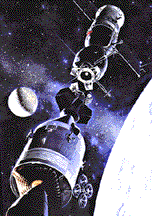|
|
Apollo-Soyuz Test Project

The Apollo-Soyuz mission occurred in July, 1975. In addition to
the manned mission objectives of international space cooperation,
testing universal docking systems, etc., Apollo-Soyuz carried a number
of scientific instruments.
The U.S. portion of the mission carried a proportional counter system
sensitive to 0.18-0.28 and 0.6-10.0 keV X-rays. The total effective area
was 0.1 sq-m, and there was a 4.5 degree FWHM circular field of view.
Results from this experiment included the discovery of soft X-ray emission
from the supernova remnant MSH 14-63 and of rapid pulsations (0.716 s) from
the binary SMC X-1. Due to the (comparatively) short duration of the
Apollo-Soyuz mission, little other science of note was done with the
proportional counter system. In addition, the detector had a moderately
high background level that steadily increased through the duration of the
mission until almost no X-ray sources were discernible. The cause of the
background problems remains unknown.
[Gallery]
[Publications]
[All Missions]
[by Time]
[by Energy]
Page authors: Lorella Angelini Jesse Allen
HEASARC Home |
Observatories |
Archive |
Calibration |
Software |
Tools |
Students/Teachers/Public
Last modified: Thursday, 24-Sep-2020 17:38:11 EDT
|


